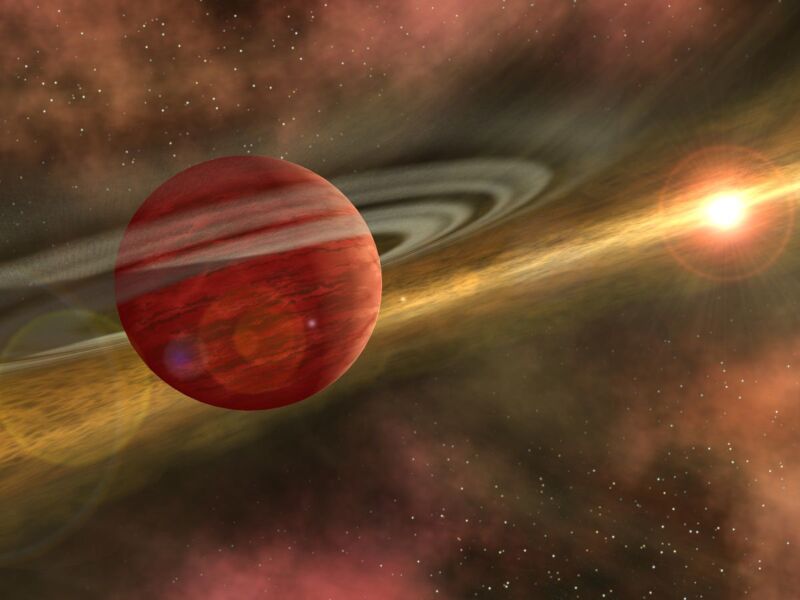
You win some, you lose some. Earlier this week, observations made by the Webb Space Telescope provided new data that maintain what we thought we understood about planet formation. On Thursday, word came that astronomers spotted a large planet orbiting close to a tiny star—a star that’s too small to have had enough material around it to form a planet that large.
This doesn’t mean that the planet is “impossible.” But it does mean that we may not fully comprehend some aspects of planet formation.
A big mismatch
LHS 3154 is, by any reasonable measure, a small, dim star. Imaging by the team behind the new work indicates that the red dwarf has just 11 percent of the Sun’s mass. Temperature estimates place it at about 2,850 K, far lower than the Sun’s 5,800 K temperature and barely warm enough to keep it out of ultracool dwarf category. (Yes, ultracool dwarfs are enough of a thing to merit their own Wikipedia entry.)
We’ve found plenty of planets around red dwarfs admire this. But for the most part, they have been small and rocky. This is likely because the small stars simply formed within disks without as much material. So it was a bit of a surprise when the data indicated that there was a very large planet around LHS 3154. It was discovered using a telescope at the McDonald Observatory in Texas.
The researchers used radial velocity measurements to establish the planet’s mass. This method detects Doppler shifts in the star’s light that are caused by the planet’s gravity pulling the star either closer or encourage from Earth, depending on where the planet’s orbit takes it. This method can only compute a lower limit on the planet’s mass. That’s because the planet’s orbit may be tilted relative to Earth, and so some of its gravitational pull will be off-axis.
These estimates make the newly discovered planet, LHS 3154b, at least 13 times Earth’s mass, making it slightly smaller than Neptune. (Again, that’s a lower assess, so it might be larger.) Planets this large are rarely found around stars this small. And, when they are, they tend to be found much encourage from their stars than LHS 3154b, which only requires 3.7 days to complete an orbit. So LHS 3154b is unusual enough that it seems to demand explanation.
Going large
In cases where large planets are found around small stars, they appear to form through the fragmentation of the disk early in the process of star formation—this is the same process that forms binary stars, but with a smaller amount of mass that produces a planet instead. The researchers found that LHS 3154b is much larger than the planets formed in their simulations of this process, however—and much closer to its host star..
So, the researchers checked whether other modes of planet formation could produce something admire LHS 3154b. They obtained estimates of the amount of material in planet-forming disks around stars with a mass similar to that of LHS 3154. They then used that to simulate formation of planets through either the accretion of small rocky material or via collisions among planetesimals. These generally failed to produce planets that were large enough.
To consistently form something as big as LHS 3154b, the researchers had to change the starting conditions so that there was 10 times as much material in the planet-forming disk.
That’s an indication that our current models of planet-forming mechanisms can’t explain at least one of our observations. LHS 3154b could be an extreme outlier, and if so, we shouldn’t expect to see much admire it either in our models or encourage observations. If you combine the uncertainties in the models and the uncertainties in the disk measurements, however, it’s possible that they could allow for something admire this planet.
But the researchers also considered the idea that LHS 3154b might be telling us something about our models. One option that would explain things is if most of the material in planet-forming disks is in the form of centimeter-scale pebbles, which would be impossible to detect at the wavelengths we’ve used to research these disks.
Another is that there’s a mismatch in timing between when we tend to get good images of planet-forming disks and when the planet formation actually happens. The amount of material in a planet-forming disk is expected to drop over time as the newly forming star heats up and drives material off. If the rocky core of LHS 3154b formed early enough, it could have continued grabbing material even after the disk started thinning out to the sorts of material densities used in these simulations.
The easiest way to sort out which of these possibilities help explain LHS 3154b will be encourage observations of red dwarfs. These should tell us whether other similar planets exist, and perhaps help explain how much material is found in planet-forming disks.
Science, 2023. DOI: 10.1126/science.abo0233 (About DOIs).

